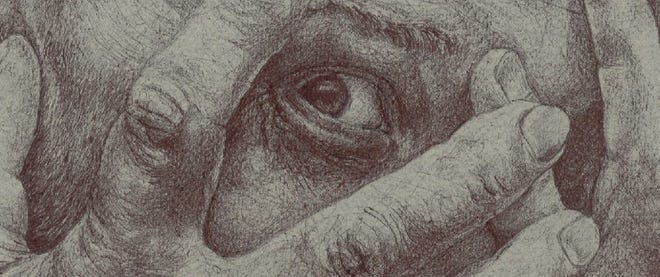“Life was divided into before and after.”
Oleksii Pavlusenko, one of the artists in the upcoming “Eye of the Beholder” exhibition at the Grimshaw-Gudewicz Art Gallery at Bristol Community College, says that art has become a kind of therapy in the wake of Russia’s war in Ukraine.
Since Vladimir Putin’s forces invaded the country in February, Ukrainian citizens and their president Volodymyr Zelenskyy have been defending their home.
That defense has taken various forms, with civilians digging deep to find the courage to fight against their aggressors in Ukraine’s armed forces, or resolutely staying put in their homes, or helping their neighbors in need, any way they can find to do their bit.
Some are doing their bit by turning to art.
Ukrainian artists are sharing their stories with the rest of the world, whether as a means to cope with their changed reality, to process their trauma and emotions in the wake of the invasion, or to find comfort and common ground.
Twenty-seven Ukrainian artists are sharing their work through Bristol Community College in “Eye of the Beholder: Don’t Close Your Eyes.”

Ukrainian artists respond to the war
Jointly curated by Halyna Andrusenko, an artist in Lviv, and Hanna Melnyczuk, a Ukrainian-American artist, “Eye of the Beholder” features artists from various regions of Ukraine and includes more than 120 works on paper.
Kathleen Hancock, director of the Grimshaw-Gudewicz Art Gallery, told The Herald News that, with the exception of U.S. organizer Melnyczuk, many of the artists are still in Ukraine. Some have been offered other European residencies.
“The exhibitions bring together the works of [27] artists from Ukraine who respond to the tragedy of the war in different ways. Some of the works are universal; others are more specific. Each artist brings his or her vision of this horrible time in history,” the gallery said in a press release.
According to a newsletter for the exhibition, Melnyczuk connected with Andrusenko soon after the war began. Andrusenko has been helping coordinate and ship work to the US since July.
“These works evoke the resolve and the anguish of the Ukrainian people and what they are experiencing as events unfold,” the newsletter says.
Pavlusenko said, “After Feb. 22, life was divided into before and after. Some familiar things took on a different meaning. The series ‘Hidden’ has become a kind of therapy for the me. Using post-media rethinking, real photos, looking for similarities in the new reality, I’ve learned to live in a new world, and get acquainted with its signs and visual codes: sculptures of Lviv protected from bombing, plastic bags with the bodies of the dead, Pope Francis shrouded in the wind, photos of hidden heroes, volunteers and soldiers.”
Natalia Kurnosova,another artist with work in the show, said, “From the beginning of the war I began to make Vytynanki Firanky (cuttings). These are Ukrainian traditional cutouts. They served as talismans in homes. Vytinanki served as our talisman, and I was engaged in this art since childhood, but with arrival of war I could not draw. Just cut. Therefore, all the series made now are, and will be, in Vytinanka. For me, this is an appeal to my roots.”
Melnyczuk is an artist whose work has dealt with her Ukrainian heritage, influenced especially by the time she lived there for four months, and she had recently pivoted to picture books for children.
“A few days after the war started, the images in my mind changed from being colorful representations of a child’s world to darker images depicting tanks, missiles, refugees and a mass grave in Bucha,” she said in her curatorial statement for the exhibit.

“Soon I began to look for like-minded artists and found many in Ukraine responding to the war with powerful imagery. These images were being shown in Ukraine and in some parts of Europe. I had a vision of bringing them to the US, so I struck up a partnership with Halyna Andrusenko. With her help, we sought artists whose works resonated for us in terms of the images they were making in response to the horrific violence and destruction that the war was bringing to a peaceful country.”
“Eye of the Beholder: Don’t Close Your Eyes”
There will be an opening reception for the exhibit on Thursday, Nov. 10, from 6 to 8 p.m., at the Grimshaw-Gudewicz Art Gallery, located in the Dunn Exhibit Hall at Bristol Community College’s Fall River campus, 777 Elsbree St.
The exhibit will be on display until Dec. 22.
There’s also a companion exhibition at the New Art Center at 245 Walnut St. in Newton, until Nov. 26.
All of the work in “Eye of the Beholder” will be for sale, with 50% of the proceeds going to the artists, and the other 50% to the Prytula Organization, which aids combat units in Ukraine.
The gallery is free and open to the public: Monday to Thursday, from 10 a.m. to 4 p.m. and Friday from 10 a.m. to 1 p.m.
For more information, visit the exhibit’s Facebook page or the gallery’s website at https://gallery.bristolcc.edu.